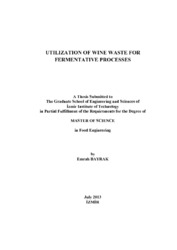Please use this identifier to cite or link to this item:
https://hdl.handle.net/11147/3568Full metadata record
| DC Field | Value | Language |
|---|---|---|
| dc.contributor.advisor | Büyükkileci, Ali Oğuz | en |
| dc.contributor.author | Bayrak, Emrah | - |
| dc.date.accessioned | 2014-07-22T13:51:49Z | |
| dc.date.available | 2014-07-22T13:51:49Z | |
| dc.date.issued | 2013 | en |
| dc.identifier.uri | http://hdl.handle.net/11147/3568 | |
| dc.description | Thesis (Master)--Izmir Institute of Technology, Food Engineering, Izmir, 2013 | en |
| dc.description | Includes bibliographical references (leaves: 59-62) | en |
| dc.description | Text in Englisg; Abstract: Turkish and English | en |
| dc.description | xi, 62 leaves | en |
| dc.description.abstract | Grape pomace is generally considered as most valuable waste of winemaking process. Two different grape types of Syrah (red) and Muscat (white) were collected in the middle of the harvest season after pressing steps of both red and white wine making process Carbohydrate content of grape pomace was hydrolysed by enzymatic and acid hydrolysis. After screening possible fermentable sugars of grape pomace lactic acid fermentation were performed from grape pomace suspension and liquid extract phase. Lactic acid fermentation by Lactobacillus casei showed that grape pomace can be used as a substrate for lactic acid production. Different solid loadings and yeast extract concentrations effect the lactic acid production yield from grape pomace. Enzymatic hydrolysis was performed to hydrolyse pectin, cellulose and hemicellulose of grape pomace. Commercial pectinase, cellulase and β-glucosidase were supplemented into grape pomace suspensions at different concentrations. Maximum hydrolysed glucose and xylose from extracted solid phase of grape pomace were calculated as 8.93 ± 0.21 and 4.52 ± 0.11 % of total solid. Furthermore, acid hydrolysis showed that two stages acid hydrolysis is more efficient in releasing glucose from extracted solid phase of grape pomace but dilute acid hydrolysis is also more efficiency on hydrolysis of xylose and arabinose. Exo-polygalacturonase production from grape pomace was conducted using different filamentus fungi, namely Aspergillus sojae, Rhizopus oryzae and Aspergillus niger but no significant enzyme activity was obtained. Maximum 84 % of fermentable sugar in dry grape pomace was converted to lactic acid by L. casei. Effect of yeast extract researches designated that commercial yeast (bakers’ yeast) can be used as nitrogen source instead of yeast extract and 10 g/l of yeast extract was the most suitable concentration for lactic acid production from grape pomace by L.casei. This study showed the potential of the grape pomace for fermentative processes. | en |
| dc.language.iso | en | en_US |
| dc.publisher | Izmir Institute of Technology | en |
| dc.publisher | Izmir Institute of Technology | en_US |
| dc.rights | info:eu-repo/semantics/openAccess | en_US |
| dc.subject.lcsh | Wine and wine making Chemistry. | en |
| dc.subject.lcsh | Wine and wine making--Analysis | en |
| dc.title | Utilization of wine waste for fermentative processes | en_US |
| dc.type | Master Thesis | en_US |
| dc.institutionauthor | Bayrak, Emrah | - |
| dc.department | Thesis (Master)--İzmir Institute of Technology, Food Engineering | en_US |
| dc.relation.publicationcategory | Tez | en_US |
| item.languageiso639-1 | en | - |
| item.fulltext | With Fulltext | - |
| item.openairecristype | http://purl.org/coar/resource_type/c_18cf | - |
| item.openairetype | Master Thesis | - |
| item.grantfulltext | open | - |
| item.cerifentitytype | Publications | - |
| Appears in Collections: | Master Degree / Yüksek Lisans Tezleri | |
Files in This Item:
| File | Description | Size | Format | |
|---|---|---|---|---|
| T001100.pdf | MasterThesis | 1.54 MB | Adobe PDF |  View/Open |
CORE Recommender
Page view(s)
142
checked on Jul 22, 2024
Download(s)
118
checked on Jul 22, 2024
Google ScholarTM
Check
Items in GCRIS Repository are protected by copyright, with all rights reserved, unless otherwise indicated.